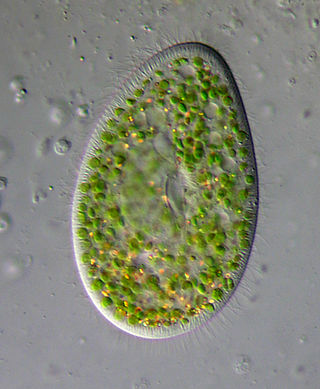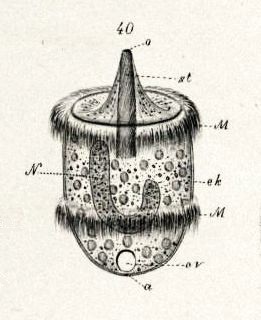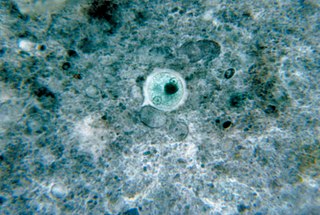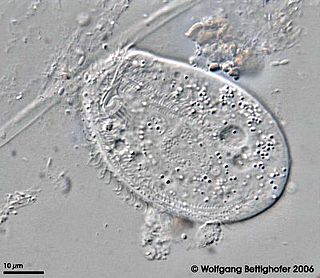
The alveolates are a group of protists, considered a major clade and superphylum within Eukarya. They are currently grouped with the stramenopiles and Rhizaria among the protists with tubulocristate mitochondria into the SAR supergroup.

The cryptomonads are a group of algae, most of which have plastids. They are common in freshwater, and also occur in marine and brackish habitats. Each cell is around 10–50 μm in size and flattened in shape, with an anterior groove or pocket. At the edge of the pocket there are typically two slightly unequal flagella.

The peritrichs are a large and distinctive group of ciliates.

The Litostomatea are a class of ciliates. The group consists of three subclasses: Haptoria, Trichostomatia and Rhynchostomatia. Haptoria includes mostly carnivorous forms such as Didinium, a species of which preys primarily on the ciliate Paramecium. Trichostomatia (trichostomes) are mostly endosymbionts in the digestive tracts of vertebrates. These include the species Balantidium coli, which is the only ciliate parasitic in humans. The group Rhynchostomatia includes two free-living orders previously included among the Haptoria, but now known to be genetically distinct from them, the Dileptida and the Tracheliida.

Paramecium is a genus of eukaryotic, unicellular ciliates, commonly studied as a model organism of the ciliate group. Paramecium are widespread in freshwater, brackish, and marine environments and are often abundant in stagnant basins and ponds. Because some species are readily cultivated and easily induced to conjugate and divide, they have been widely used in classrooms and laboratories to study biological processes. The usefulness of Paramecium as a model organism has caused one ciliate researcher to characterize it as the "white rat" of the phylum Ciliophora.

A unicellular organism, also known as a single-celled organism, is an organism that consists of a single cell, unlike a multicellular organism that consists of multiple cells. Organisms fall into two general categories: prokaryotic organisms and eukaryotic organisms. Most prokaryotes are unicellular and are classified into bacteria and archaea. Many eukaryotes are multicellular, but some are unicellular such as protozoa, unicellular algae, and unicellular fungi. Unicellular organisms are thought to be the oldest form of life, with early protocells possibly emerging 3.8–4.0 billion years ago.
Tracy Morton Sonneborn was an American biologist. His life's study was ciliated protozoa of the group Paramecium.

The synaptonemal complex (SC) is a protein structure that forms between homologous chromosomes during meiosis and is thought to mediate synapsis and recombination during prophase I during meiosis in eukaryotes. It is currently thought that the SC functions primarily as a scaffold to allow interacting chromatids to complete their crossover activities.

Stentor, sometimes called trumpet animalcules, are a genus of filter-feeding, heterotrophic ciliates, representative of the heterotrichs. They are usually horn-shaped, and reach lengths of two millimeters; as such, they are among the largest known extant unicellular organisms. They reproduce asexually through binary fission.

Paramecium bursaria is a species of ciliate found in marine and brackish waters. It has a mutualistic endosymbiotic relationship with green algae called Zoochlorella. About 700 Chlorella cells live inside the protist's cytoplasm and provide it with food, while the Paramecium provides the algae with movement and protection. P. bursaria is 80-150 μm long, with a wide oral groove, two contractile vacuoles, and a single micronucleus as well as a single macronucleus. P. bursaria is the only species of Paramecium that forms symbiotic relationships with algae, and it is often used in biology classrooms both as an example of a protozoan and also as an example of symbiosis.

Didinium is a genus of unicellular ciliates with at least ten accepted species. All are free-living carnivores. Most are found in fresh and brackish water, but three marine species are known. Their diet consists largely of Paramecium, although they will also attack and consume other ciliates. Some species, such as D. gargantua, also feeds on non-ciliate protists, including dinoflagellates, cryptomonads, and green algae.

A microbial cyst is a resting or dormant stage of a microorganism, that can be thought of as a state of suspended animation in which the metabolic processes of the cell are slowed and the cell ceases all activities like feeding and locomotion. Many groups of single-celled, microscopic organisms, or microbes, possess the ability to enter this dormant state.

Protozoa are a polyphyletic group of single-celled eukaryotes, either free-living or parasitic, that feed on organic matter such as other microorganisms or organic debris. Historically, protozoans were regarded as "one-celled animals".

Colpoda is a genus of ciliates in the class Colpodea, order Colpodida, and family Colpodidae.

The ciliates are a group of alveolates characterized by the presence of hair-like organelles called cilia, which are identical in structure to eukaryotic flagella, but are in general shorter and present in much larger numbers, with a different undulating pattern than flagella. Cilia occur in all members of the group and are variously used in swimming, crawling, attachment, feeding, and sensation.

Chilodonella uncinata is a single-celled organism of the ciliate class of alveoles. As a ciliate, C. uncinata has cilia covering its body and a dual nuclear structure, the micronucleus and macronucleus. Unlike some other ciliates, C. uncinata contains millions of minichromosomes in its macronucleus while its micronucleus is estimated to contain 3 chromosomes. Childonella uncinata is the causative agent of Chilodonelloza, a disease that affects the gills and skin of fresh water fish, and may act as a facultative of mosquito larva.

Climacostomum is a genus of unicellular ciliates, belonging to the class Heterotrichea.
Chlorovirus, also known as Chlorella virus, is a genus of giant double-stranded DNA viruses, in the family Phycodnaviridae. This genus is found globally in freshwater environments where freshwater microscopic algae serve as natural hosts. There are 19 species in this genus.
Autogamy, or self-fertilization, refers to the fusion of two gametes that come from one individual. Autogamy is predominantly observed in the form of self-pollination, a reproductive mechanism employed by many flowering plants. However, species of protists have also been observed using autogamy as a means of reproduction. Flowering plants engage in autogamy regularly, while the protists that engage in autogamy only do so in stressful environments.

Protists are the eukaryotes that cannot be classified as plants, fungi or animals. They are mostly unicellular and microscopic. Many unicellular protists, particularly protozoans, are motile and can generate movement using flagella, cilia or pseudopods. Cells which use flagella for movement are usually referred to as flagellates, cells which use cilia are usually referred to as ciliates, and cells which use pseudopods are usually referred to as amoeba or amoeboids. Other protists are not motile, and consequently have no built-in movement mechanism.

















